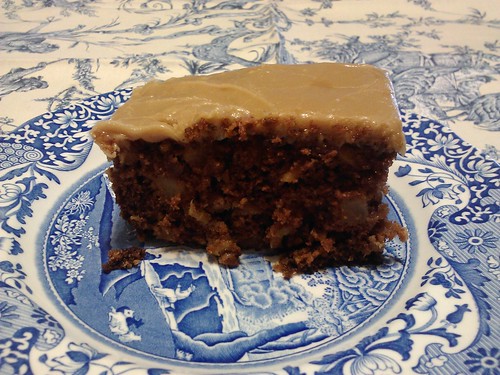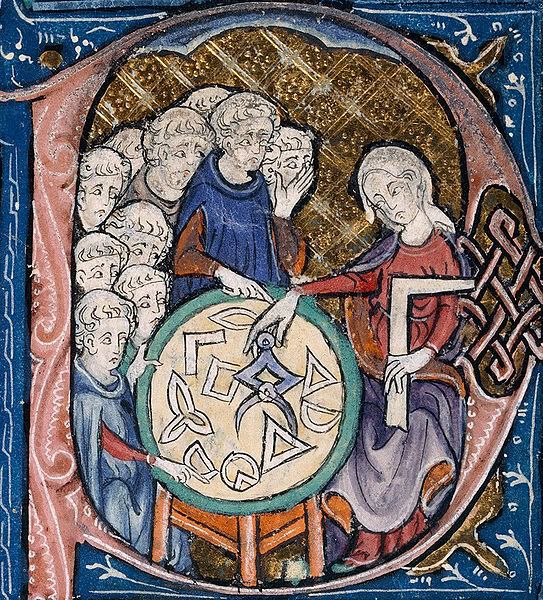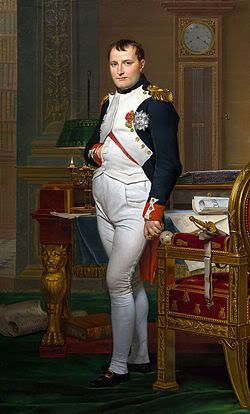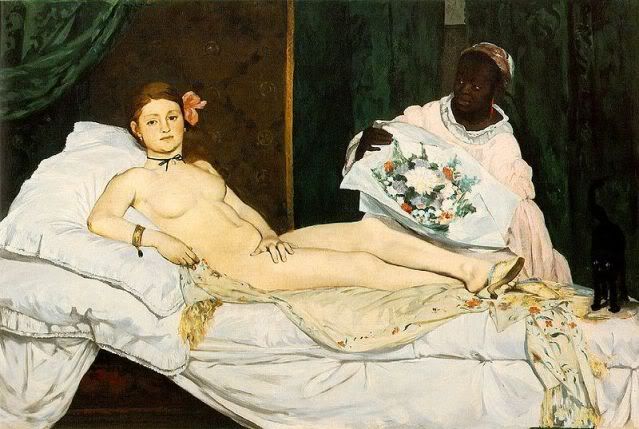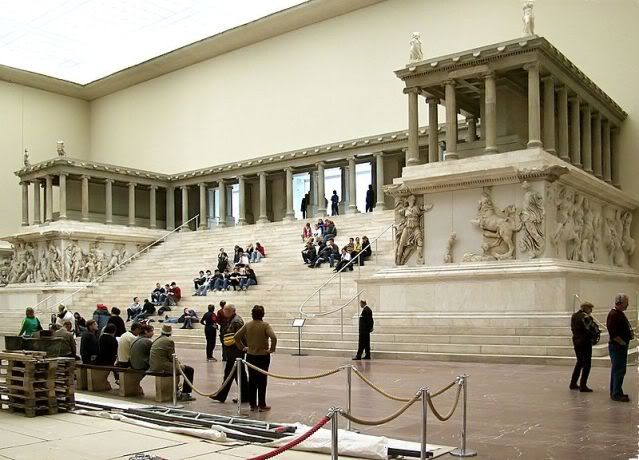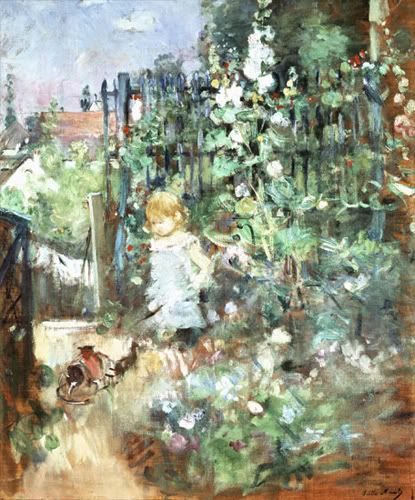There are dozens of recipes for "Washington Apple Cake" out there, but this one is special for a couple of reasons. The first is that the recipe for this cake was handed down to me from my Great-Grandmother (whom I believe discovered it in the newspaper). The second is that it contains a lot more (and different) spices than most apple cakes! Most ask for no more than two teaspoons of cinnamon, whereas this recipe calls for two tablespoons, plus a 1/2 teaspoon of nutmeg. The cinnamon might seem excessive when you are making the cake (the batter is practically red, and the cake IS red when you take it out of the oven). But the apple/cinnamon/nutmeg combination actually produces a mild cinnamon flavour once it has been baked (I can't stand things that have heavy-handed flavours, so trust me when I say it's not spicy!). The cake is perfectly moist and topped with a delectable caramel frosting. A wonderful treat for a chilly fall evening!
Washington Apple Cake
1/2 cup butter
1 1/2 - 2 c. sugar
2 eggs
2 cups flour
2 tsp. baking soda
1/2 tsp. nutmeg
2 T cinnamon
1/2 tsp. salt
6 large apples - 3-4 cups diced (peeled)
2 tsp. vanilla
Oven 350 degrees 35 min. (That's all my great-grandmother wrote, but I would recommend baking until a toothpick inserted in the cake comes out clean, which is about 40 minutes).
Caramel Frosting
1/2 cup butter
1/2 teaspoon salt
2 T evaporated milk
1 cup firmly packed brown sugar
Mix in small saucepan and heat lightly to just melt butter. Mix until sugar dissolves. Add enough confectioners sugar to make consistency right for spreading.
Those are the directions that came with the recipe. You will notice there are no directions provided for the cake - I think my great grandmother expected you to know how to mix a cake! Personally, I always prepare my wet ingredients and dry ingredients seperately and then add the dry ingredients to the wet in my mixer.
I find it really funny that she equates 6 large apples with 3 cups of diced apples! Today's apples are much, much larger than they were 100 years ago.(it reminds me of recipes from the colonial period, where they tell you to use 1/2 dozen eggs when three would do today - eggs were a lot smaller then!). For this recipe, I used 4 galas, which equaled about four cups when finely diced. Also, I would add that you can safely increase the amount of apples in the cake up to 4-5 cups. If you are using apples from your own orchard, then it will probably take six!
I made this cake for tea last week, and my oldest daughter (who just turned two) had a wonderful time eating cake and drinking tea from real teacups. This was her first tea party, and she clearly felt like quite the little grown-up!
Monday, November 14, 2011
Washington Apple Cake
Posted by
Margaret
at
12:57 PM
7
comments
![]()
![]()
Labels: recipes
Monday, November 7, 2011
I'm back!
I'm back! I have been enjoying time with both my lovely daughters (the youngest of whom - shown above - is now just a little over 2 months old). This time I really allowed myself to take a break from blogging, social media etc., and it's been a wonderful experience. That said, I feel that it's just about time to return to the virtual world! I definitely have missed you all, and hopefully there are some readers left, since I realize that three months is an eternity in blogging!
I also have to admit that one thing that has kept me from coming back sooner is that I've been having a bit of an identity crisis over what I would like The Earthly Paradise to be, especially now that I no longer have as much free time to devote to writing more serious Art History stuff (something I realize I haven't done in a while). Also, I can't help but notice that my interests have changed quite a bit since I first started this blog back in 2007! So, there might be a few tweaks in the works, which is something that I've been debating with myself about for quite a while. I'm still not entirely sure what this will mean, so stay tuned!
Posted by
Margaret
at
1:42 PM
9
comments
![]()
![]()
Labels: news
Wednesday, August 3, 2011
Art History Carnival August 2011
Welcome to the August 3, 2011 edition of the art history carnival!
architecture
"Well into the 19th century, the educated viewer could read a building as one reads a book, but today the language of classicism is largely mute to us, much of its meaning lost and eroded by time and the relentless evolution of human societies." Andrew Zega and Bernd H. Dams presents a symbolism refresher-course in Architectural Symbolism 101: Geometry posted at NOTED @ Architectural Watercolors
Helen Webberley presents Napoleon's house in exile: St Helena posted at ART and ARCHITECTURE, mainly, saying, "When Napoleon Bonaparte was sent into exile for a second time, his British captors were very serious about him not escaping again. So they selected St Helena Island, a remote Atlantic island located in the tropics off the west coast of Africa.
Longwood House was Napoleon’s residence, from Dec 1815 until his death in May 1821. Formerly the summer residence of the Lieutenant Governor, Longwood was converted for the use of Napoleon in 1815 and then expanded. Architectural plans and photographs are available. Longwood House has since been accurately restored by French curators and now the house is now an important historical museum owned by the French government."
art history
Feeling in the mood for a little mystery? David Clark shares Piece 22 – Michelangelo’s Fight in the Brancacci Chapel | Michelangelo's Puzzle posted at Michelangelo's Puzzle, saying, "Michelangelo's Puzzle is a 90 piece blog story that will reveal the secret message on the Sistine Chapel ceiling on November 1, 2012 - the 500th anniversary of the ceiling's dedication."
Sedef Piker presents a review of Professor Mary Garrard's landmark article exploring the reception of women artists in the Renaissance, with a focus on Sofonisba Anguissola in Sofonisba Anguissola and the Problem of the Woman Artist posted at Three Pipe Problem
H Niyazi presents Platonic receptacles, Leonardo and the Salvator Mundi posted at Three Pipe ProblemThe post presents a summary of the available provenance and technical data of the newly attributed Leonardo painting depicting Christ as 'Salvator Mundi'. H also provides an iconographical survey of the 'Salvator Mundi' motif in art through preceding ages and examines a Platonic reading for Leonardo's unique depiction of the orb in Christ's left hand, a departure from traditional depictions of a 'globus cruciger'."
Susan Benford compares and contrasts Edouard Manet's Olympia with Titian's Venus of Urbino in Famous Painters: Edouard Manet (she also raises an interesting question: Cezanne and Manet have both been referred to as the "fathers of modern art" - which artist deserves it more?). The post can be found her blog Famous Paintings Reviewed - An Art History Blog.
Finally, Francis P. DeStefano explores the artistic relationship between Giorgione and Titian (and raises interesting questions, such as, could Titian have been hired by Giorgione as a contract worker?)in his post Giorgione and the Young Titian posted at Giorgione et al...
That concludes this edition. Thank-you to everyone who participated. I would also like to thank those who sent in submissions that I was unable to include due to the age of the posts. I have been receiving a lot of wonderful posts each month (thank-you to everyone who has worked so hard to get the word out about the carnival!), which has made it impossible to include older posts.
I will be making an announcement shortly as to whom will be hosting the next issue of the Carnival, since it falls right around my due date (my husband and I are expecting a new addition to the family at the end of this month). I imagine I'll have my hands full next month!
Technorati tags:
art history carnival, blog carnival.
Posted by
Margaret
at
8:05 AM
4
comments
![]()
![]()
Labels: blog carnival
Wednesday, July 27, 2011
Call for Submissions for the August Issue of the Art History Carnival
The August edition of the Art History Carnival will be posted on Wednesday, August 3, 2011. You can submit articles for inclusion in the carnival until 48 hours before the issue comes out (Monday, August 1st).
What kind of blog articles will be included?
Posts covering all periods and art mediums are welcome, as are posts discussing art criticism, architecture, design, theory and aesthetics. All submissions will be carefully reviewed, so please, no spam.
What is a Blog Carnival?
According to Wikipedia, a blog carnival is "a type of blog event...similar to a magazine, in that it is dedicated to a particular topic, and is published on a regular schedule, often weekly or monthly. Each edition of a blog carnival is in the form of a blog article that contains permalinks links to other blog articles on the particular topic."
Blog Carnivals are a great way to help your blog reach a new audience and to make new friends in the blogosphere!
Who can submit?
Anyone, as long as you have a blog! And If you don't blog, you can submit one of your friend's articles (except they better be good--I'll be reading them!).
Can I host a carnival?
Absolutely! Please let me know if you'd be interested in hosting the next issue of the carnival.
How to submit articles
You have two options:
1. Use the submission form provided by Blog Carnival (this is easiest!).
2. Send me an email. Include the title and permalink URL of the post you are nominating for inclusion in the carnival, along with the name of the blog. Please put "Art History Carnival" in the title of your email to help me recognize it in my inbox!
One final thing to keep in mind:
To keep things current, posts should have been written after the date of the last Carnival. If a post is six months old, I won't be able to include it in the Carnival, no matter how great it is.
Thank you for your participation! Share the news with other bloggers!
Posted by
Margaret
at
8:27 AM
0
comments
![]()
![]()
Labels: blog carnival, news
Tuesday, July 26, 2011
Florence + The Machine, The Band Perry and the Lady of Shalott in Music Videos
Today I thought I'd share a video from Florence + The Machine. My husband actually made me sit down and watch the video because he noticed all the mythological and Pre-Raphaelite references! We first encountered Florence + The Machine while watching the Colbert Report, and our first reaction (other than noticing that she had a great voice), was that she looked like she'd fallen out of a Pre-Raphaelite painting. Apparently this is no coincidence, and you'll notice that most of her videos contain references to the Pre-Raphaelites, though the video for "Rabbit Heart" is one of the most overt. From the minute you see the water behind her you can tell this is going to end in a send-up of the Lady of Shalott!
For an even heavier dose of the Lady of Shalott, check out The Band Perry's "If I Die Young". My daughter actually discovered this one on Vevo the other day!
Someone from the band is clearly a big fan of the Pre-Raphaelites! Of course Lady of Shalott is the most obvious reference (the video actually closes with a shot of Tennyson's poem), but I thought the scene at :38 (with the mother at the window) was a little evocative of John Everett Millais' Mariana. It's a very well done video, and the song is beautiful as well.
Posted by
Margaret
at
4:09 PM
5
comments
![]()
![]()
Labels: millais, music, mythology, pre-raphaelites
Wednesday, July 6, 2011
Art History Carnival July 2011
And now to the July edition of the Art History Carnival...
art history
Monica Bowen presents altar of pergamon and baroque scholarship posted at Alberti's Window, saying, "This post largely deals with historiography, explaining why Baroque scholarship became popular in the late 19th and early 20th century." The post examines how the arrival of the Altar of Pergamon in Berlin caused revived interest in Baroque art because of the similarity it bore to the Baroque style (amusingly, some scholars even began referring to the Hellenistic style as "ancient Baroque").
Susan Benford presents Famous Paintings of Berthe Morisot posted at Famous Paintings Reviewed - An Art History Blog. Morisot was the first female artist to exhibit her works with the French Impressionists (the painting above is entitled "Child with Staked Roses", 1881). Her paintings are lovely and I appreciate that Susan has taken the time to share a little more about Berthe's life and work!
Next, take a moment to stroll along the streets of Paris with Anna (a student of Dr Ben Harvey, who is blogging as part of an independent study class on 19th century art from Paris), who has written a lovely blog post about one of her walking tours near her Paris Apartment entitled The Neighborhood posted at anna on art. Manet's Gare Saint-Lazare (shown above) is one of the many paintings that was created just a stone's throw away. Also, I highly recommend that you take time to read another of her posts, "Manet: Inventeur du Moderne," which she published July 5th. It's a lovely review of a current exhibit at the Musée d’Orsay, and is not to be missed!
exhibits
Paul Doolan presents a fascinating review of Rodchenko and Ai Weiwei in Photography Museum, Winterthur posted at ThinkShop. The exhibit highlights the artists' differing "takes" on communism. Rodchenko (shown above left) began his artistic life rather enamored of the Soviet Revolution, while Ai Weiwei recently experienced a brief stint in Chinese prison as the result of his subversive art.
Helen Webberley presents Vienna Art and Design exhibition, in Melbourne posted at ART and ARCHITECTURE, mainly, saying, "A blockbuster exhibition in Melbourne called "Vienna Art and Design: Klimt, Schiele, Hoffmann and Loos" prompted a re-analysis of the Vienna Secession. The paintings, architecture, furniture, jewellery and textiles explore and display modernism, individualism, nationalism and the creation of a new style concentrating on the use of colour, design and opulent glamour."
philosophy of art
Jean-Michel Basquiat's work catapulted him to rock-star status in the early 1980s. Although he died at just 27 years of age, his work continues to fascinate and inspire. junhax reviews a documentary of his life and work in Jean-Michel Basquiat | Junhax posted at Junhax
That concludes this edition. Submit your blog article to the next edition of
art history carnival
using our
carnival submission form.
Past posts and future hosts can be found on our
blog carnival index page.
Technorati tags:
art history carnival, blog carnival.
Posted by
Margaret
at
7:20 AM
8
comments
![]()
![]()
Labels: blog carnival
Thursday, June 23, 2011
Call for Submissions for the July Issue of the Art History Carnival
What kind of blog articles will be included?
Posts covering all periods and art mediums are welcome, as are posts discussing art criticism, architecture, design, theory and aesthetics. All submissions will be carefully reviewed, so please, no spam.
What is a Blog Carnival?
According to Wikipedia, a blog carnival is "a type of blog event...similar to a magazine, in that it is dedicated to a particular topic, and is published on a regular schedule, often weekly or monthly. Each edition of a blog carnival is in the form of a blog article that contains permalinks links to other blog articles on the particular topic."
Blog Carnivals are a great way to help your blog reach a new audience and to make new friends in the blogosphere!
Who can submit?
Anyone, as long as you have a blog! And If you don't blog, you can submit one of your friend's articles (except they better be good--I'll be reading them!).
Can I host a carnival?
How to submit articles
You have two options:
1. Use the submission form provided by Blog Carnival (this is easiest!).
2. Send me an email. Include the title and permalink URL of the post you are nominating for inclusion in the carnival, along with the name of the blog. Please put "Art History Carnival" in the title of your email to help me recognize it in my inbox!
One final thing to keep in mind:
To keep things current, posts should have been written after the date of the last Carnival. If a post is six months old, I won't be able to include it in the Carnival, no matter how great it is.
Posted by
Margaret
at
1:29 PM
2
comments
![]()
![]()
Labels: blog carnival

